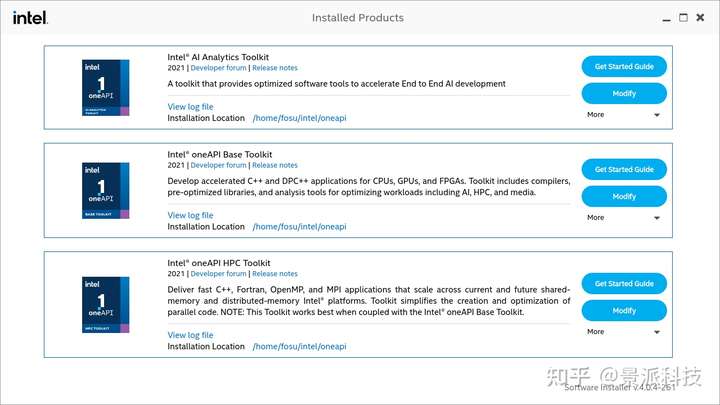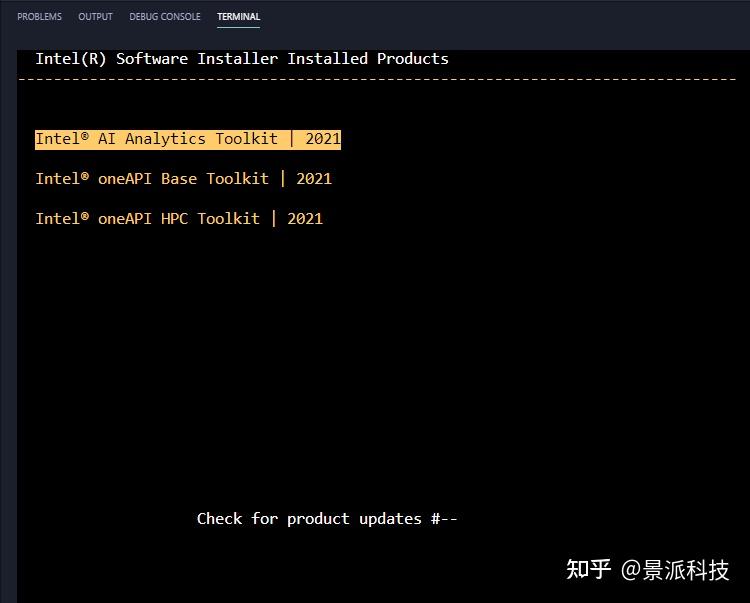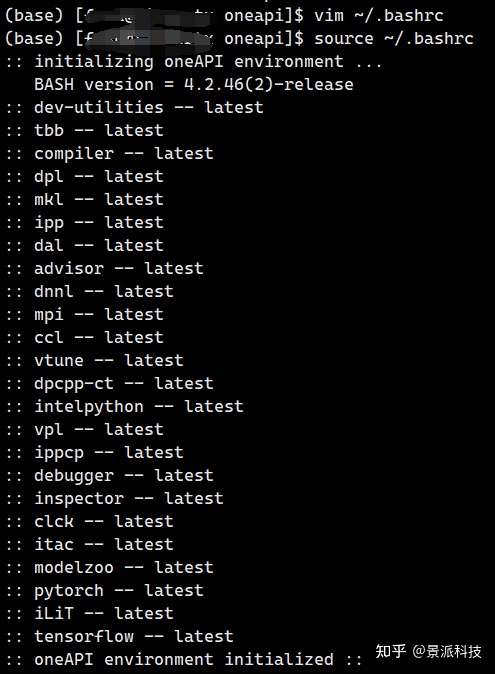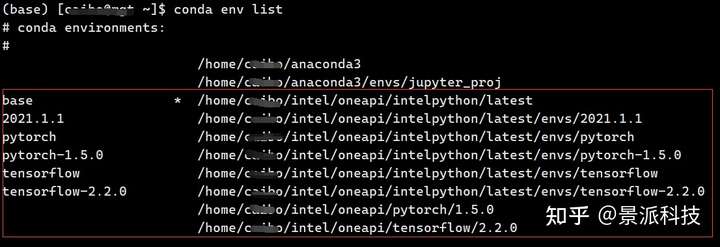景派HPC研究院丨Intel oneAPI环境变量配置&运行一个PyTorch程序
景派HPC研究院
由景派科技的技术团队组成,主要分享高性能计算领域的技术信息,与解答各位朋友在技术上遇到的问题和瓶颈,欢迎大家在文章下方的评论区讨论与提问。
早期的两篇文章(https://blog.csdn.net/weixin_44506674/article/details/110413364、https://blog.csdn.net/weixin_44506674/article/details/110990718)我简单介绍了Intel oneAPI的安装以及关于Intel oneAPI各大工具包的一些基础知识,从本篇文章开始将正式讲解如何使用Intel oneAPI中的AI工具包。
1. 查看已安装的oneAPI工具包
运行 oneAPI 安装路径(默认为~/intel/oneapi)下的installer程序即可查看自己安装了哪些 oneAPI 工具包。
以我自己的为例,运行如下命令(具体路径以自己实际设置为准)
cd ~/intel/oneapi/installer/
./installer如果你的连接工具支持X11转发,则会看到如下图形界面:

如果你的连接工具不支持X11转发,则只会进入文字界面如下图所示:


Intel 的所有程序都是既有图形界面又有文字界面的,可以说考虑得非常周全了,必须点赞。
2. 设置oneAPI的环境变量
同样是在oneAPI的安装路径下,有一个setvars.sh的文件,这个文件包含了你所安装的所有oneAPI工具包的环境变量。如果只是临时使用Intel oneAPI,则只需要在每次使用之前执行命令source ~/intel/oneapi/setvars.sh intel64即可;若需要长期生效也不难,咱们只需要在/etc/profile或者~/.bashrc里面source它即可。如下图为我在~/.bashrc文件中设置oneAPI的环境变量的步骤:
2.1 修改用户环境变量文件
在~/.bashrc的末尾加入如下语句:
source /home/fosu/intel/oneapi/setvars.sh intel64
2.2 使环境变量立即生效
source ~/.bashrc
可以看到第一次source已经成功了,接下来就可以用 oneAPI 了。
随便测试了一下,已经都可以用了:

3. 激活Intel oneAPI的conda环境
也许你会问:我安装好了oneAPI的AI工具包,也设置好了环境变量,我要怎么使用oneAPI提供的优化版PyTorch以及Tensorflow呢?
经常使用Python搞开发或者搞机器学习的同学一定知道Anaconda,而oneAPI中提供的优化版Pytorch以及Tensorflow其实也是以Anaconda虚拟环境的形式提供给我们用的。
3.1 查看oneAPI提供的Anaconda虚拟环境
在激活了oneAPI环境变量之后,使用如下命令:
conda env list会发现Anaconda中多出来几个路径里面带有oneAPI的虚拟环境,如下图所示:

所以就清晰了,要使用oneAPI提供的优化版Pytorch或者Tensorflow,咱们只需要根据需求激活相应的Anaconda虚拟环境就可以了。
3.2 激活Intel oneAPI的Anaconda虚拟环境
为了演示,我激活了名为pytorch的oneAPI虚拟环境,并且查看这个虚拟环境里面都有些什么。
conda activate pytorch
conda list输出结果如下:
# packages in environment at /home/***/intel/oneapi/intelpython/latest/envs/pytorch:
#
# NameVersion BuildChannel
asn1crypto1.4.0py37h22e6299_2file:///home/caibo/intel/oneapi/conda_channel
blas1.0 mklfile:///home/caibo/intel/oneapi/conda_channel
bzip2 1.0.8h88c068d_5file:///home/caibo/intel/oneapi/conda_channel
certifi 2020.6.20py37hefe589e_1file:///home/caibo/intel/oneapi/conda_channel
cffi1.14.3 py37h698c159_1file:///home/caibo/intel/oneapi/conda_channel
chardet 3.0.4py37h82fad40_4file:///home/caibo/intel/oneapi/conda_channel
common_cmplr_lib_rt 2021.1.1intel_189file:///home/caibo/intel/oneapi/conda_channel
common_cmplr_lic_rt 2021.1.1intel_189file:///home/caibo/intel/oneapi/conda_channel
conda 4.8.4 py37h926af72_10file:///home/caibo/intel/oneapi/conda_channel
conda-package-handling1.4.1py37he46c983_4file:///home/caibo/intel/oneapi/conda_channel
cpuonly 1.0 0file:///home/caibo/intel/oneapi/conda_channel
cryptography3.2py37h89119f4_1file:///home/caibo/intel/oneapi/conda_channel
dpcpp_cpp_rt2021.1.1intel_189file:///home/caibo/intel/oneapi/conda_channel
freetype2.10.4 h9e62b58_0file:///home/caibo/intel/oneapi/conda_channel
icc_rt2021.1.1intel_189file:///home/caibo/intel/oneapi/conda_channel
idna2.10 py37he452417_1file:///home/caibo/intel/oneapi/conda_channel
intel-extension-for-pytorch 1.0.1 py3.7_cpu_0file:///home/caibo/intel/oneapi/conda_channel
intel-openmp2021.1.1intel_189file:///home/caibo/intel/oneapi/conda_channel
intelpython 2021.1.11file:///home/caibo/intel/oneapi/conda_channel
jpeg9b h024ee3a_2file:///home/caibo/intel/oneapi/conda_channel
lark-parser 0.9.0pyh9f0ad1d_0file:///home/caibo/intel/oneapi/conda_channel
libarchive3.4.2hadfc6af_6file:///home/caibo/intel/oneapi/conda_channel
libffi3.3 h07ac4c1_13file:///home/caibo/intel/oneapi/conda_channel
libgcc-ng 9.3.0hdf63c60_101file:///home/caibo/intel/oneapi/conda_channel
libpng1.6.37 h17b3f18_7file:///home/caibo/intel/oneapi/conda_channel
libstdcxx-ng9.3.0hdf63c60_101file:///home/caibo/intel/oneapi/conda_channel
libtiff 4.1.0h2733197_1file:///home/caibo/intel/oneapi/conda_channel
libxml2 2.9.10 h9aba842_4file:///home/caibo/intel/oneapi/conda_channel
lz4-c 1.9.2h7708b8d_3file:///home/caibo/intel/oneapi/conda_channel
lzo 2.10 ha2aa7bf_5file:///home/caibo/intel/oneapi/conda_channel
mkl 2021.1.1 intel_52file:///home/caibo/intel/oneapi/conda_channel
mkl-service 2.3.0py37hfc5565f_6file:///home/caibo/intel/oneapi/conda_channel
mkl_fft 1.2.0py37hb9c2cde_4file:///home/caibo/intel/oneapi/conda_channel
mkl_random1.2.0py37h90a4e38_4file:///home/caibo/intel/oneapi/conda_channel
mkl_umath 0.1.0py37hb46b53c_0file:///home/caibo/intel/oneapi/conda_channel
ninja 1.9.0py37hfd86e86_0file:///home/caibo/intel/oneapi/conda_channel
numpy 1.19.2 py37h02626c5_0file:///home/caibo/intel/oneapi/conda_channel
numpy-base1.19.2 py37h591eb60_0file:///home/caibo/intel/oneapi/conda_channel
olefile 0.46 py37_0file:///home/caibo/intel/oneapi/conda_channel
opencl_rt 2021.1.1intel_189file:///home/caibo/intel/oneapi/conda_channel
openssl 1.1.1h h14c3975_0file:///home/caibo/intel/oneapi/conda_channel
pillow7.1.2py37hb39fc2d_0file:///home/caibo/intel/oneapi/conda_channel
pip 20.2.3 py37h56aae7b_1file:///home/caibo/intel/oneapi/conda_channel
pycosat 0.6.3py37h4822089_6file:///home/caibo/intel/oneapi/conda_channel
pycparser 2.20 py37h310c2dd_2file:///home/caibo/intel/oneapi/conda_channel
pyopenssl 19.1.0 py37h4200cf5_2file:///home/caibo/intel/oneapi/conda_channel
pysocks 1.7.0py37h4200cf5_2file:///home/caibo/intel/oneapi/conda_channel
python3.7.9h7af079d_1file:///home/caibo/intel/oneapi/conda_channel
python-libarchive-c 2.8 py37h4200cf5_14file:///home/caibo/intel/oneapi/conda_channel
pytorch 1.5.0 py3.7_cpu_0file:///home/caibo/intel/oneapi/conda_channel
pyyaml5.3.1py37h1acd8f6_0file:///home/caibo/intel/oneapi/conda_channel
requests2.24.0 py37h35012da_0file:///home/caibo/intel/oneapi/conda_channel
ruamel_yaml 0.15.99py37ha45e144_6file:///home/caibo/intel/oneapi/conda_channel
setuptools50.3.2 py37h4200cf5_0file:///home/caibo/intel/oneapi/conda_channel
six 1.15.0 py37h65307dc_1file:///home/caibo/intel/oneapi/conda_channel
sqlite3.33.0 h88c068d_1file:///home/caibo/intel/oneapi/conda_channel
tbb 2021.1.1intel_119file:///home/caibo/intel/oneapi/conda_channel
tbb4py2021.1.1 py37_intel_119file:///home/caibo/intel/oneapi/conda_channel
tcl 8.6.9 h14c3975_27file:///home/caibo/intel/oneapi/conda_channel
tk8.6.9h88fb5b1_8file:///home/caibo/intel/oneapi/conda_channel
torch-ccl 1.0.1pypi_0pypi
torch-ipex1.0.1pypi_0pypi
torch_ccl 1.0.1 py3.7_cpu_0file:///home/caibo/intel/oneapi/conda_channel
torchvision 0.6.0py37_cpu[cpuonly]file:///home/caibo/intel/oneapi/conda_channel
tqdm4.50.2 py37hf3d76cd_0file:///home/caibo/intel/oneapi/conda_channel
urllib3 1.25.10py37h9e79bd7_1file:///home/caibo/intel/oneapi/conda_channel
wheel 0.35.1 py37h4a4c509_1file:///home/caibo/intel/oneapi/conda_channel
xz5.2.5hcc43529_2file:///home/caibo/intel/oneapi/conda_channel
yaml0.1.7h04e08d9_7file:///home/caibo/intel/oneapi/conda_channel
zlib1.2.11.1 hb8a9d29_3file:///home/caibo/intel/oneapi/conda_channel
zstd1.4.5hdb51d2f_0file:///home/caibo/intel/oneapi/conda_channel可以发现,这个虚拟环境使用了Python 3.7.9、Pytorch 1.5.0以及其他很多oneAPI提供的工具比如intel-openmp、intel-extension-for-pytorch,至于这些工具怎么用以及AI工具包的具体介绍和代码样例,大家可以直接去官网查看(https://software.intel.com/content/www/us/en/develop/tools/oneapi/ai-analytics-toolkit.html),文档很齐全,我后续也会逐渐深入。
3.3 使用oneAPI虚拟环境运行PyTorch程序
为了演示效果,这里使用我的环境运行oneAPI官网提供的一个PyTorch_Hello_World.py程序,具体代码如下:
#!/usr/bin/env python
# encoding: utf-8
'''
==============================================================
Copyright © 2019 Intel Corporation
SPDX-License-Identifier: MIT
==============================================================
'''
import torch
import torch.nn as nn
from torch.utils import mkldnn
from torch.utils.data import Dataset, DataLoader
'''
BS_TRAIN: Batch size for training data
BS_TEST:Batch size for testing data
EPOCHNUM: Number of epoch for training
'''
BS_TRAIN = 50
BS_TEST= 10
EPOCHNUM = 2
'''
TestDataset class is inherited from torch.utils.data.Dataset.
Since data for training involves data and ground truth, a flag "train" is defined in the initialization function. When train is True, instance of TestDataset gets a pair of training data and label data. When it is False, the instance gets data only for inference. Value of the flag "train" is set in __init__ function.
In __getitem__ function, data at index position is supposed to be returned.
__len__ function returns the overall length of the dataset.
'''
class TestDataset(Dataset):
def __init__(self, train = True):
super(TestDataset, self).__init__()
self.train = train
def __getitem__(self, index):
if self.train:
return torch.rand(3, 112, 112), torch.rand(6, 110, 110)
else:
return torch.rand(3, 112, 112)
def __len__(self):
if self.train:
return 100
else:
return 20
'''
TestModel class is inherited from torch.nn.Module.
Operations that will be used in the topology are defined in __init__ function.
Input data x is supposed to be passed to the forward function. The topology is implemented in the forward function. When perform training/inference, the forward function will be called automatically by passing input data to a model instance.
'''
class TestModel(nn.Module):
def __init__(self):
super(TestModel, self).__init__()
self.conv = nn.Conv2d(3, 6, 3)
self.norm = nn.BatchNorm2d(6)
self.relu = nn.ReLU()
def forward(self, x):
x = self.conv(x)
x = self.norm(x)
x = self.relu(x)
return x
'''
Perform training and inference in main function
'''
def main():
'''
The following 3 components are required to perform training.
1. model: Instantiate model class
2. optim: Optimization function for update topology parameters during training
3. crite: Criterion function to minimize loss
'''
model = TestModel()
optim = torch.optim.SGD(model.parameters(), lr=0.01)
crite = nn.MSELoss(reduction='sum')
'''
1. Instantiate the Dataset class defined before
2. Use torch.utils.data.DataLoader to load data from the Dataset instance
'''
train_data= TestDataset()
trainLoader = DataLoader(train_data, batch_size=BS_TRAIN)
test_data = TestDataset(train=False)
testLoader= DataLoader(test_data, batch_size=BS_TEST)
'''
Perform training and inference
Use model.train() to set the model into train mode. Use model.eval() to set the model into inference mode.
Use for loop with enumerate(instance of DataLoader) to go through the whole dataset for training/inference.
'''
for i in range(0, EPOCHNUM - 1):
model.train()
for batch_index, (data, y_ans) in enumerate(trainLoader):
'''
1. Clear parameters of optimization function
2. Do forward-propagation
3. Calculate loss of the forward-propagation with the criterion function
4. Calculate gradients with the backward() function
5. Update parameters of the model with the optimization function
'''
optim.zero_grad()
y = model(data)
loss = crite(y, y_ans)
loss.backward()
optim.step()
model.eval()
'''
1. User is suggested to use JIT mode to get best performance with DNNL with minimum change of Pytorch code. User may need to pass an explicit flag or invoke a specific DNNL optimization pass. The PyTorch DNNL JIT backend is under development (RFC link https://github.com/pytorch/pytorch/issues/23657), so the example below is given in imperative mode.
2. To have model accelerated by DNNL under imperative mode, user needs to explicitly insert format conversion for DNNL operations using tensor.to_mkldnn() and to_dense(). For best result, user needs to insert the format conversion on the boundary of a sequence of DNNL operations. This could boost performance significantly.
3. For inference task, user needs to prepack the model’s weight using mkldnn_utils.to_mkldnn(model) to save the weight format conversion overhead. It could bring good performance gain sometime for single batch inference.
'''
model_mkldnn = mkldnn.to_mkldnn(model)
for batch_index, data in enumerate(testLoader):
y = model_mkldnn(data.to_mkldnn())
if __name__ == '__main__':
main()
print('[CODE_SAMPLE_COMPLETED_SUCCESFULLY]')这是一个简单的模型训练demo,在虚拟环境中直接使用python PyTorch_Hello_World.py即可运行。而对于自己的程序在这个虚拟环境中也是可以直接运行的,如果虚拟环境中的库不能满足需求(比如一般还会需要matplotlib、pandas等),直接使用命令conda install安装即可。
4. 小结
本文介绍了Intel oneAPI的环境变量配置以及基本使用方法,打通了使用流程。总的来说Intel oneAPI的AI工具包使用很方便,提供的工具包有很多, 还有很多高级用法可以参考官网的文档(https://software.intel.com/content/www/us/en/develop/tools/oneapi/documentation/library.html?query=¤tPage=1&externalFilter=rsoftware:inteloneapitoolkits/intelaianalyticstoolkit)以及程序样例(https://github.com/oneapi-src/oneAPI-samples/tree/master/AI-and-Analytics)。

